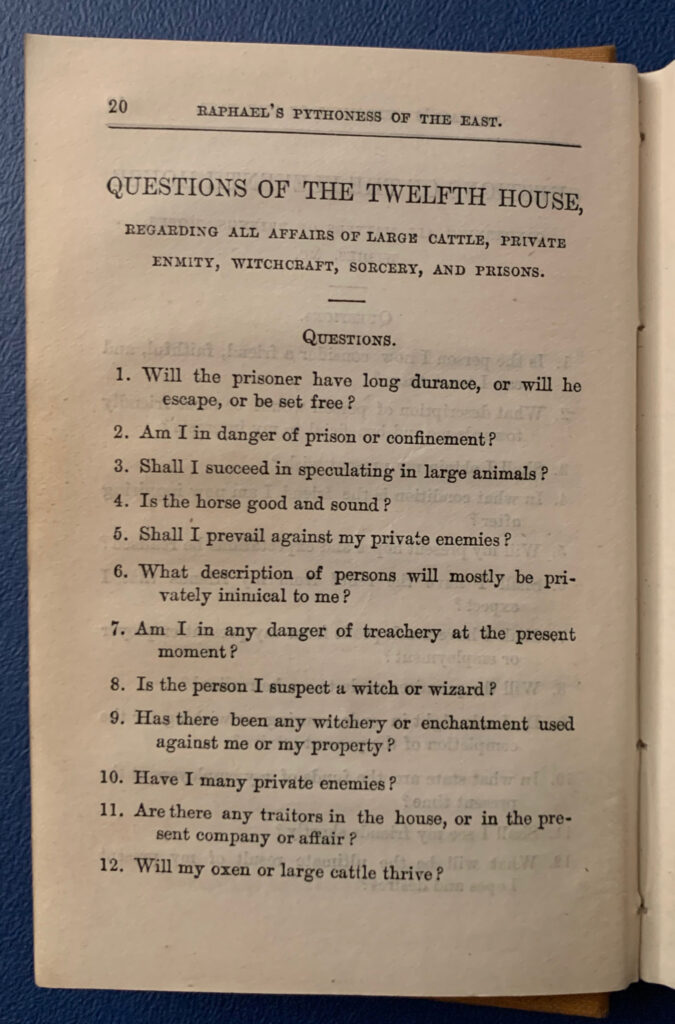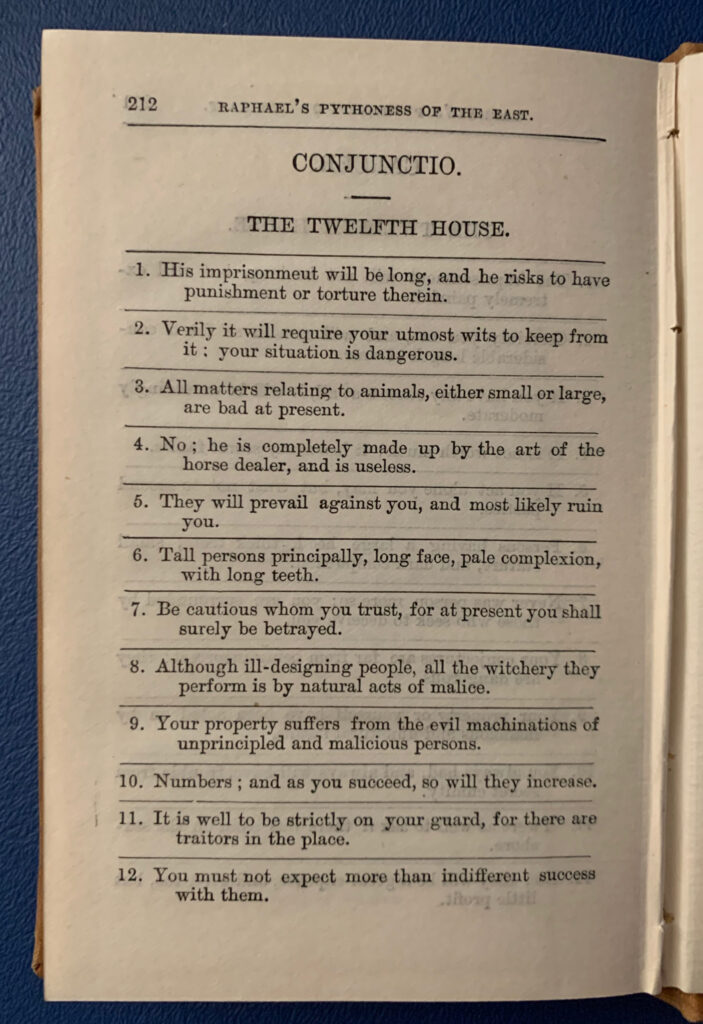Robert Cross Smith, better known as Raphael, The Astrologer of the Nineteenth Century, was a rather prolific publisher. For a short time he published a journal with the autobiographical sounding title The Straggling Astrologer. After about six months of losing money, he ended that project. He followed it with a thick tome, The Astrologer of the Nineteenth Century[1] and then a couple almanacs, The Prophetic Messenger and his Raphael’s Ephemeris. Raphael was less strictly an astrologer and more interested in a variety of practices related to divination, prophecy, and foretelling the future. One such works is his Raphael’s Pythoness of the East.

Raphael’s Pythoness of the East is exactly as advertised on the title page: “Rapheal’s Pythoness of the East; or, Complete Key to Futurity.” The reference here to the “Pythoness of the East” is likely an effort to establish historical authority by reference to the priestess of the Oracle at Delphi. Further establishing the technique’s historical authority, Raphael boasts of having translated it from the original manuscript that Empress Josephine, wife of Napoleon, and Napoleon himself had consulted. The prophetic technique, Raphael assures us, is both astonishingly successful and infallible.

The technique itself seems to be a combination of geomancy and cleromancy, liberally seasoned with astrological language. The fortune teller first puts the 32 slips of paper, two of each of the 16 geomantic figures, into a “mystic vase.” These figures are conveniently printed on small slips of paper in the front of the book.

The rest of the book is tables of questions and tables of answers, arranged by “house” (sometimes referred to as “circle”). When a person comes to ask a question, the fortune teller and the querent determine the precise form of the question, which they locate in the tables of questions organized into twelve houses (here we see echoes of astrology). Each house groups together related topics and questions, though sometimes the relationship between these topics seems rather vague. For example, “Questions of the Twelfth House” all focus on “affairs of large cattle, private enmity, witchcraft, sorcery, and prisons.”[2]

Perhaps the querent wants to know: “Shall I succeed in speculating in large animals?” This is question number 3 in the twelfth house. Now that they have determined the question, as Raphael tells us, the fortune teller holds out “vase or reticule in her left hand” and lets the querent “take (without seeing them) one of the figures out, which will determine the Geomantic Oracle under which the answer is to be sought.” Our imaginary querent who wants to know about speculating on large animals draws out “cunjunctio.”

The fortune teller then turns to the tables of answers for the twelfth house and locates the one there that corresponds to that “geomantic oracle,” here conjunctio. Then looking down to the number in that table that matches the number of the question, here the question was number 3, the fortune teller would look for the answer next to number 3: “All matters relating to animals, either small or large, are bad at present.”

The book contains 144 different questions, twelve in each of the twelve houses, that range widely, e.g., “In what month will death take place?” or “Will my father’s opponents overcome him?” or “Will the promises made to me be realized?” or “Will the absent student succeed in his studies?” To these questions there are 2,304 answers, 16 for each question.
For any given question, then, there are 16 possible answers. To question 9 in house 1, “In what month will death take place?” we read the possible responses for each of the Geomantic Oracles:
- November or December will be fatal.
- Why should’st thou ask this question? If thou must know it, August.
- The dart of Death descends in the month of September.
- Let the month of September be bored in mind; illness, accidents, or death, will arrive at that time.
- The sign of the Goat shall be fatal; it presides over December.
- At the spring of the year remember that the new flowers and buds will produce thy funeral garland.
- The life has been weighed in the scales, and September proves fatal.
- The fatal month according to the geomantic art will be April.
- Thou shalt finish the old year, but the commencement of a new one will be fatal.
- It is decreed that April or November call be fatal.
- Unless every caution be taken, the fates will cut the thread of life in the month of September.
- As the new year declines, so shall the life begin to ebb and flow. The tide ceases in October.
- The Sanctuary cautions the of September.
- Thou shalt see the May-flowers bud forth, but beware of June.
- Remember the month of April.
- The person for whom the question is asked will find the month of October fatal.
For reasons I cannot fathom, September appears to have been the deadliest month. February, March, and July, however, seem to be rather safe months. I would love to reconstruct how somebody (some people? geomancers?) determined that September was so deadly.
Raphael’s Pythoness of the East raises so many questions, about nineteenth-century occult and divination practices, about Raphael (i.e., Robert Cross Smith) and publishing, about the continued authority of geomancy, and even about today (since reprints of the book are still being sold).[3]
- Public Domain Review has a nice little post on Raphael’s The Astrologer of the Nineteenth Century. ↵
- Here, for example, is a seemingly strange family of topics. What, for instance, do large cattle (not small cattle) have to do with witchcraft or prisons? There’s a fascinating project here. ↵
- You can also find original 19th-century copies, but they are not cheap. I am rather surprised at the prices these little books command. AbeBooks lists three copies ranging from $90 to $325. ↵
